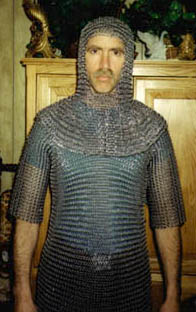

When and How Will the World End chainmail Fantasy Castles chainmail Vintage Clothing chainmail How to Beat Depression
Chainmail, also called mail, maille or chain mail is a type of armor made up of metal rings linked together in a pattern to form a mesh. This is a defensive material made to prevent blows from knives, swords and axes from cutting the skin. It can also defend against arrows in many cases. But some arrows were made with thin heads, which could break through the chainmail. Also a heavy axe or sword could break through. But chanimail gave the solider a greater chance to survive the battle.
A hauberk is the chainmail shirt that is knee length. If the chain mail shirt is goes down to mid thigh it is called a haubergeon, and a byrnie if it just goes to the waist. Chainmail leggings are called chausses, Chain mail hood a coif, and gloves mitons.
During the High Middle Ages, chainmail was used more than any other armour and it was during this time the full body chainmail suit was developed. It wasn't until until the 14th century that plate armour became popular and started to replace chainmail.
The chainmail shirt and hood you see on this page was made from stainless steal wire twisted into springs and then cut into open rings. The rings were then put together using pliers. A friend taught me what to do. I personally made the chainmail outfit over a summer just for the fun of it. Now it has been sitting around for awhile so I am trying to sell it. The Chainmail hood and shirt is real distinct in that it is made from stainless steal while most chainmail outfits you find are made from galvanize steal. It fits a slim body type and my husband who is modeling the hood and shirt is 5ft 11inches and weighs around 175 pounds.
Chain Mail Chain Mail
| More Chainmail | Chainmaille |
|
Affiliate links from EPN
More ChainMail Products:
Aluminum Lightweight Chainmail
Commissions Earned
 |
Medieval Chainmail Suit and Coif Stainless Steel |
 |
 |
We aren't sure who invented the chainmail but the earliest found was from a Celtic chieftain's gravesite located in Romania in the 5th century BC. By the 14 century mail was being replaced by the less expensive and more easily made plate armor. Instead of a full suit of chain mail a solider would use a combination part plate armor and mail. Chainmail being in the smaller and more flexible areas.In medieval times armor chainmail was used to defend against blows from a sword or arrows. The flexibility of the Chin mail made it wearable by the owner and helped ward off the blows.
My husband James is modeling the chainmail. I think he makes a good-looking knight. A few summers ago a friend taught me how to make chain mail. I used stainless steel 16-gauge wire and made the suit you see pictured. It took about 3 months and was a fun project. However this one is much heavier than the ones you usually find. The kit below is only 5 pounds while the one I made (counting both shirt and coif) is around 40 pounds. The different words for chainmail, are mail, chain maille, chain mail or chainmaille. Mail or Maille is what it was usually called in medieval times.
Chain mail is made of small medal rings linked together to form a mesh. I used a gig to wind the medal wire around a rod and the results looked like a spring. The spring was then cut, leaving me a pile of rings. I used pliers to work the rings making the shirt and hood (Coif). My chainmail was a lot easier to make than how it was made in medieval times where the metal had to be made and cut with primitive tools and welded together.
In medieval times armor chainmail was used to defend against blows from a sword or arrows. The flexibility of the Chin mail made it wearable by the owner and helped ward off the blows.
The Proper word for the chainmail shirt is the "hauberk" and the hood a "coif" while chain mail mittens were called "mitons."
The photo of the links above shows some rings I put together. You can see how they all weave together. Holding this piece in your hands does feel nice and it is fun just to dangle it and clump it up and then stretch it out again. It makes a great conversation piece if you bring it out in public. One time my brother brought the entire outfit to a renaissance party and he was made over by the other guests. Another time I brought it to a renaissance fair, but it was before I had it completed and one of the fellows looked it over and gave me some helpful tips. It was fun to see all the costumes and period clothing. I could not tell you how to make it now and I misplaced my pattern that I wrote up as I was doing it so that isn't any help either. But it is fun just to have and bring it out sometimes until I find a buyer who wants something unique made with stainless steel.
Dear ChainMail Fans,
I am writing to you in behalf of your Heavenly Father. He is seeking you like a lost sheep. You remember the Bible story? It is about a shepherd who has 100 sheep. But when he brings the sheep home one night, one is missing. He then leaves the 99 sheep and goes out into the wilderness until he finds that lost sheep.
In this parable the shepherd goes out to search for the one lost sheep-the very least that can be numbered. So if there had been but one lost soul, Christ would have died for that one. To read more click Lost Sheep
Susan Dietel
Web Programmer
Email:
susansdesign@yahoo.com
Web Site